Most of us never think about the stairs beyond whether they are capable of getting us up to bed and back down again without collapsing. Usually dressed in a simple carpet that we hope won’t show the dirt, they are largely ignored in favour of the main rooms of the house despite being the principle route through the building and one which everyone uses everyday.
But, think about it; the stairs are often the first thing people see when they come into your home and given that, especially if you’re trying to sell, buyers make up their mind within about 30 seconds of you opening the door, it might be worth taking a little time to think about the impact they are having because they might be reflecting on the rest of your property.
James Morton, director of Benham & Reeves Estate Agent, in Hampstead, north London, says: “A dramatic set of stairs is always a selling feature. We know that original period staircases add value to properties and now contemporary staircases are also becoming attractive to buyers.”
Robert Slater, of Hobart Slater, agrees: “The staircase can set the whole tone of the house and an interesting staircase nowadays is equal in importance to a good kitchen or a master suite. The wrong staircase, like a flimsy spiral, can be detrimental to a sale.”
So that’s us told then. The other point to remember is that ninety per cent of new staircases are created to access loft conversions so this is a chance to really think about what you want.
Hugo Tugman, founder of Architect Your Home, says that with the right approach a staircase can be transformed into a spectacular design feature in its own right.
“Stairs are usually literally at the heart of the home and they offer a real opportunity to create a stunning visual impact that reflects on the entire rest of the house,” he says.
“You can use glass or granite, spindle banisters or spiral staircases. There is so much scope but often the biggest barrier for homeowners is just knowing what is and isn’t possible.”
Stairs are, unsurprisingly, governed by a number of regulations, and in terms of the scale of the job, replacing your stairs is similar to knocking down a structural wall. They are subject to building regulations. If you want to know more visit staircases.org/regulations.htm. There are mathematical rules governing the depth of the tread and the height of the riser, necessary headroom and how climbable the banisters are.
The other key factor is that you shouldn’t assume a spiral staircase is the answer in a tight space. In fact, they take up just as much room as a normal flight – one is long and narrow, the other short and wide.
“When planning on the style of stairs you want, you need to know where you want to start and where you want to arrive on the floor above and then consider how to join the two,” says Tugman.
Otherwise just remember that while the work is being done you won’t be able to get upstairs so it might be worth moving out or making alternative sleeping and bathing arrangements.
Despite all the rules, Tugman says staircases can still be sculptural and beautiful: “Don’t start out by fixing on a particular style or shape. You need to sort out firstly where the stairs need to go and how to arrange them best to suit that arrangement. Once you know that you can start to play with the styles and the materials.”
And, crucially, he says that it is possible to modify and re-use the existing staircase. “Timber stairs can be turned, cut in half, extended and modified in all sorts of ways.
“The common mistake is to assume that you can just go out and buy a staircase but for the most part they will need to be made to fit a particular house.”
When it comes to the styling, a glass staircase is often seen as the ultimate in contemporary design. It can look great and while the technology has made great leaps forward, it’s not natural staircase material. So prepare to blow the budget out of the water. One alternative is to consider a glass balustrade which is easier to engineer and will still bring a contemporary feel to your house.
Richard Maclane, design director of Bisca staircases (www.bisca.co.uk), says: “Glass staircases really step up the ‘wow’ factor because they can give the impression of floating which is a stunning effect.
“The main issue with glass is the safety both on the grounds of visibility and slipping. Building regs stipulate a visible strip at least 50mm wide across the front edge to give grip and make each step individually visible.
“Another way to make it safer and give impact is with integrated lighting using built in LEDs.”
Tugman says the days of people wanting a grand “Gone with the Wind” sweeping staircase have largely gone. “The first thing is that the worry that a modern staircase won’t fit with a period property has disappeared. People are being very adventurous. We have done stairs where each tread has been hung on a series of fine wires, where the treads stick out of the wall on one side and where the bottom step just hovers over the floor.”
The nature of a staircase means that there will be that awkward space at the bottom which is often used for storage. If you are replacing your staircase then take time to really think about how to use that space. If you have a large hall, it can make a good home office. Or try to really kit it out with proper hooks and shelving so that each member of the family has their own space for coats and boots.
One of Tugman’s projects involved cutting out the risers of the old staircase and replacing them with frames so that drawers could be inserted into the flight, giving masses of extra, and hidden storage.
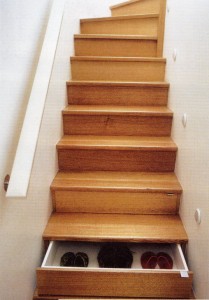
“I have also seen a house where the split level living room was linked with three wide steps and the top step had been converted into a drawer so the owner could store completed jigsaw puzzles.”
If you don’t actually need a new staircase and, more likely, the cost is making you feel faint, then start looking at the decorative options. Change the banisters to allow more light to flow through is an easier option and will bring a more modern look. Painted stairs in different colours can look fun. Some people paint words on the risers going up. Another trick if your wood isn’t in a bad condition is to paint the treads and wallpaper or varnish the risers to really make a statement. Roger Oates makes fabulous stripy runners in a range of colours that will brighten up and otherwise traditional flight of stairs while Alternative Flooring has just launched a range of spotty carpets called Dotty:

WHAT WILL IT COST?
A standard straight staircase (and most people will have a turn) can start at around £250 but expect to pay from around £3,000 for a basic bespoke flight – which is what most people will need. If you’re looking at glass and more adventurous designs, then start thinking around £25,000 and keep going until you run out of numbers. The most expensive one Bisca ever created cost £145,000.
By the way, the Bisca staircases pictures were take by Jake Fitzjones. I took the one of Dotty. His are better.
Here is the staircase from @QuirkandRescue. She has painted it fluorescent pink and added a collection of old 70s trays up the walls.
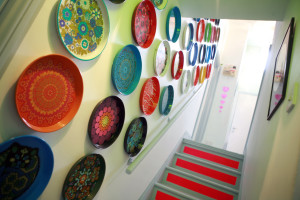

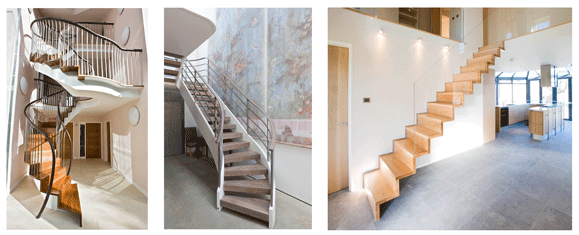
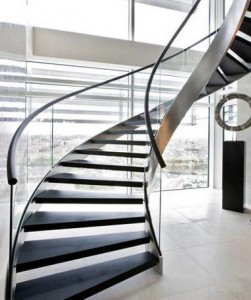
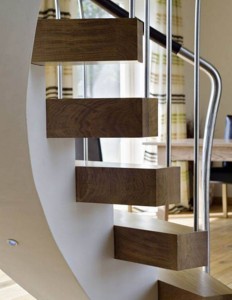
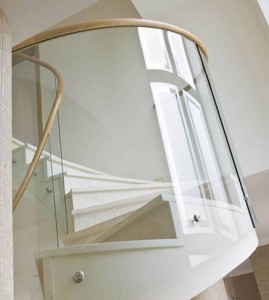
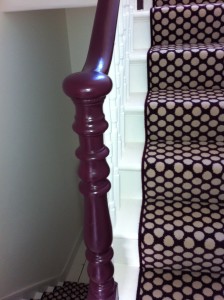
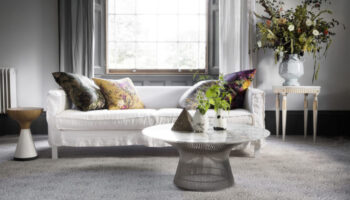
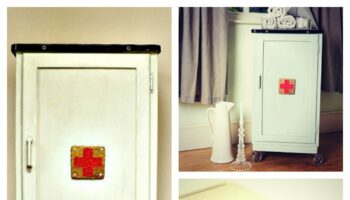
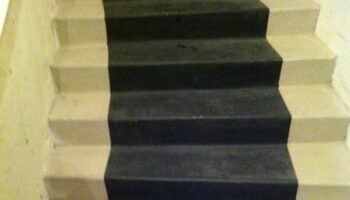

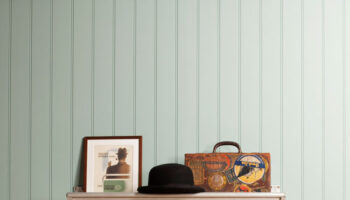
Hi Kate
We’re starting from scratch with a new staircase. We were going to do carpet upstairs and parquet flooring downstairs, would you recommend keeping the stairs the same as them? Or doing something completely different?
Thanks
Hi Elizabeth,I think the best way to connect the two is probably to have a runner up the stairs which is halfway between a wooden floor and carpet and will link the two different areas really well.See the Your House section for a post on stair carpets and runners.
You can either have the same carpet as upstairs or perhaps choose a patterned one (there are some great ones these days that aren’t all pub swirls) that has similar colours to the carpet you choose for the rest of the upstairs which lead the eye upwards and introduce the upstairs colour scheme. A stair runner is also a more modern look that full width carpet as well as absorbing the noise. It’s amazing how much noise a person makes running up and down a wooden staircase. Let us know what you decide and be sure to take before and after pictures.
LOVE the shoe draw in bottom step!
I love the combination of grey and pink. Mine is the picture above of the spotty carpet with the matching painted handrail. Perhaps you can send us a picture for Your House?
Similar to the forgotten hallway and so easy to make a statement with. I’ve noticed a lot more decorative stairs in the last few years with no barriers to colour of pattern. Recently saw a picture of a staircase where every stair was painted like a pantone colour card,that was lovely. Ours is painted grey and pink.